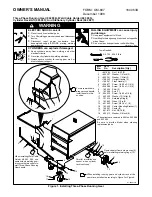
ENGLISH
21
Duty factor
The duty factor indicates the on time in % of the total operating cycle time. Duty factor 60% at
operating cycle time of 10 minutes corresponds to 6 minutes welding and 4 minutes no load.
Nominal duty factor applies at the nominal current. At lower currents the on time, and with that the
duty factor, can be higher.
Never use the unit with a higher duty factor than that stated.
Overloading and/or too high duty factor can damage the unit and/or shorten its life.
Overloading can also stop the unit from working.
Preparation
Use a welding helmet, safety gloves and suitable working clothes.
Connect the earth clamp to the workpiece and connect the electrode holder to the unit.
Use a positive or negative connection, depending on the welding electrodes used.
Use
Connect the unit to the power source and turn on the power source.
Switch on the unit. The white status lamp comes on.
Set the required welding current.
Insert an electrode in the electrode holder and weld.
Switch off the unit after welding is finished.
Switch off the power source.
Miscellaneous
When the overheating protection has not triggered, the yellow status lamp is off. When the
overheating protection trips the yellow status lamp comes on and it’s not possible to weld.
The unit can be transported using the carrying strap and handles.
Long welding cables can reduce the welding current, which can give a poor welding result.
Fluctuating mains voltage can affect the function of the unit.
If the mains voltage is more than 10% lower than the nominal input voltage for the unit the following
can occur.
Too low welding current.
The welding arc becomes unstable or extinguishes.
If the mains voltage is more than 20% higher than the nominal input voltage for the unit the
following can occur.
The overheating protection triggers.
The unit does not working properly.
The light from the arc irritates and causes burns to the eyes and skin.
Spatter and slag can cause damage to the eyes and skin.
Use welding goggles or a welding helmet.
Welding helmets must comply with relevant parts of the standard EN175.
MAINTENANCE
Check at regular intervals that the unit is working properly and meets the applicable safety
requirements.
Any improper use can cause a malfunction and damage to property.
Switch off the unit and the power source before carrying out maintenance and/or inspections.
Regularly clean the unit inside and out with compressed air or a cloth.
Regularly check switches, earth connections, conductors, connectors, electrode holder and bolted
joints. Remove any rust and tighten any loose bolted joints and/or connections.
Regularly measure the unit’s insulation resistance. The insulation resistance must be at least 1 M
Ω
between the primary and secondary windings and between windings and earth.
Repairs and the replacement of parts must only be carried out by qualified personnel.
Summary of Contents for 210-024
Page 23: ......



































